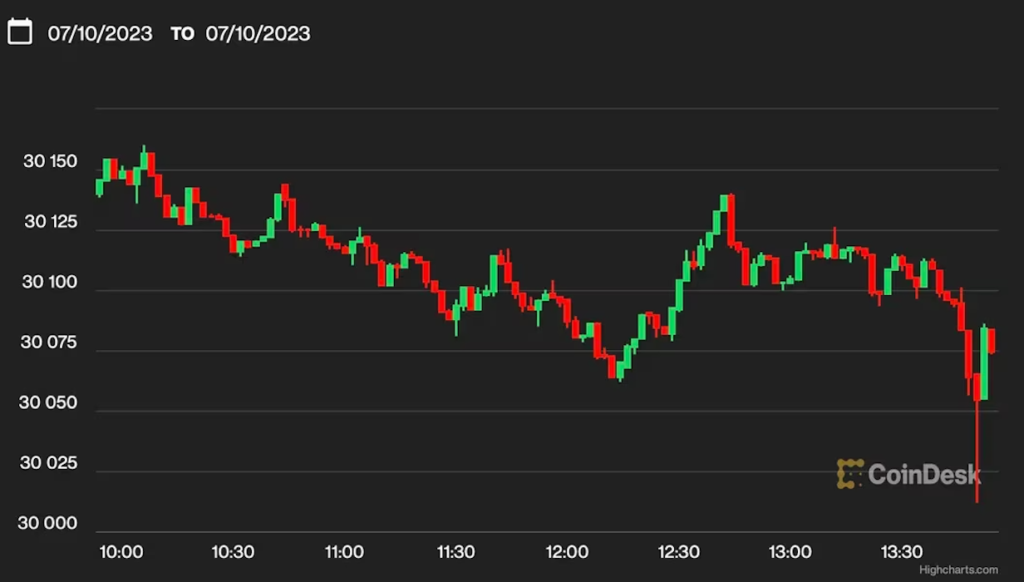
China’s Producer Price Index (PPI) data suggests the global liquidity tightening cycle that rocked risk assets, including cryptocurrencies, that began early last year is coming to an end. Bitcoin (BTC) held firm above $30,000 on July 10.
China’s National Bureau of Statistics (NBS) announced on July 10 that the producer price index (PPI) in June fell 5.4% year-on-year, marking the ninth consecutive month of decline and the largest decline in the past seven years. rice field.
This is due to lower export prices and adeflationary pressureseems to lead to China is the largest trading partner of the world’s major economies. Deflation is a sustained fall in the general price level that occurs when inflation becomes negative.

 Bitcoin price chart (CoinDesk/Highcharts.com)
Bitcoin price chart (CoinDesk/Highcharts.com)Sustained deflation in the world’s largest supplier of manufactured goods would help Western central banks. Aggressive rate hikes by central banks aimed at curbing inflation, which has been at high levels in recent years, possibly decades, in Europe and the United States have hit the economy as a whole.
The US Federal Reserve Board (Fed) has raised interest rates by more than 5% since March 2022, with the base interest rate in the range of 5% to 5.25%. In Europe, Credit Suisse was bailed out by Swiss rival UBS.
“China is exporting disinflation to the West,” David Brickell, director of institutional sales at crypto liquidity network Paradigm, told CoinDesk. “It is reflected in producer prices, but not yet fully reflected in consumer prices. Ultimately, this will be good for risk assets in relation to the end of the global hiking cycle. ”.
US producer prices rose 1.1% for the year in May, their lowest level in about two and a half years. The consumer price index (CPI) rose 4%, the lowest in two years. Data from Refinitiv cited by CNN shows June’s CPI increase is expected to slow further to 3.1% in June.
Slow response to China PPI
So far, though, China’s PPI data hasn’t sparked a risk-on rally, bitcoin is directionless above $30,000, and S&P 500-linked futures are trading 0.5% lower. there is The dollar index rose 0.15% to 102.42.
Investors now seem to be focusing on the negative aspects of the data. China’s continued decline suggests the economic recovery is stalling. Earlier this year, analysts said China’s economic recovery would be a big tailwind for global growth and risk assets.
The weakness in S&P 500 futures and Asian stock markets after the data release stems from the strong relationship between global earnings and China’s producer prices. “The latest PPI doesn’t bode well for earnings,” said Jeroen Blokland, founder of True Insights.tweeted.
According to Brickell, if bond yields peak, Bitcoin will turn to its next rally.
“The natural reaction is to look at the negative impact of slowing growth in China,” Brickell said. “Risk assets are also adapting to last week’s bond sell-off. If yields rise, stocks could stabilize. Especially given the weakness of the dollar, I think a yield reversal could trigger BTC’s next rally. anticipate”.
Yields on 10-year U.S. Treasuries rose to a four-year, four-month high of 4.09% last week, while two-year yields hit a four-year, four-month high of 4.09%, while two-year yields hit a sharp boost in U.S. ADP private payrolls announced on Thursday. It was the highest level recorded since 2006.
Nonfarm payrolls released on Monday showed a slowdown in job creation in June, but yields remained on an upward trend as the unemployment rate fell along with an unexpected rise in average hourly wages.
Rising bond yields tend to curb inflows into risky assets. Yields could fall if inflation continues to slow in the June U.S. Consumer Price Index (CPI), which is released on Wednesday.
|Translation: CoinDesk JAPAN
|Editing: Toshihiko Inoue
| Image: CoinDesk/Highcharts.com
|Original: Bitcoin Steady Above $30K as China Factory Deflation Suggests End of Global Tightening Cycle Is Near
The post China’s deflation suggests the end of monetary tightening ─ BTC is firm above $ 30,000 | CoinDesk JAPAN | CoinDesk Japan appeared first on Our Bitcoin News.

 2 years ago
147
2 years ago
147














 English (US) ·
English (US) ·